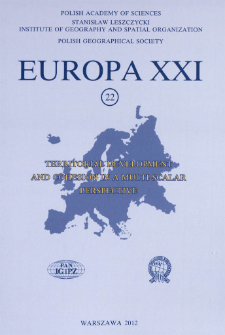- Search in all Repository
- Literature and maps
- Archeology
- Mills database
- Natural sciences
Advanced search
Advanced search
Advanced search
Advanced search
Advanced search

Object
Title: Large and Medium-Sized Towns in Bulgaria in Regional Development and Regional Policy
Subtitle:
Publisher:
Place of publishing:
Description:
Type of object:
References:
1. Enyedi G., 2005, Processes of regional development in Post-socialist Hangary, in Barta, G., E.G.Fekete, I.K. Szorenyjne, J. Timar. Hungarian Spaces and places: patterns of transition, Pecs.
2. ESPON 1.1.1., 2004, Potentials for policentric development in Europe. Final report.
3. ESPON 2013 PROGRAMME. European observation network on territorial development and cohesion.European Commission, November 2007. www.mrrb.government.bg/20.10.2011
4. Fassmann H., 1997, Regionale Transformationsforschung. Theoretische Begrundung und empirischeBeispiele, in Regionale Transformationnsprozesse in Europa. Beitrage zur Regionalen Geographie,44, Leipzig.
5. Fassmann H., 2000, Regions in upheaval. Conceptual framework and empirical findings of theregional transformation research, in G. Horvath (ed.), Regions and cities in the global world,Pecs.
6. First ESPON 2013 synthesis report, ESPON results by summer 2010. Luxembourg, October, 2010,www.espon.eu/27.10.2011
7. Horvath G., 2009, Cohesion Deficiencies in Eastern and Central Europe – Inequalities of RegionalResearch Area, DISCUSSION PAPERS, 72, Centre for Regional Studies of Hungarian Academyof Sciences, Pecs.
8. Iliev I., 1995, Formirane na Plevenskata aglomeracia i antropogenio transformirane na nejnataterytoria. [Formation of Pleven agglomeration and anthropogenic transformation of its territory],Unpublished Ph.D. thesis, Sofia University (in Bulgarian).
9. Ilieva M., 2006, Sofia in the transformation period 1990-2004: trends and prospects, in T. Komornicki,K. Czapiewski (eds.), Core and peripheral regions in Central and Eastern Europe. EuropaXXI, 14:95-112.
10. Ilieva M., 2011, Territorial differences in transformation processes in Bulgaria, Journal of Urban andRegional Analysis, vol. III, 1:13-25.
11. Komornicki T., Siłka P. (Eds.), 2011, Functional linkages between polish metropolises, Polish Academyof Sciences, Committee for Spatial Economy and Regional Planning, Warszawa.
12. Naredba No 5 ot 17.05.1995 za pravila i normi po teritorialno i selishtno ustrojstvo [Regulation #5from 17.05.1995 for regulations and norms of territorial and settlements organization]. Darzhavenvestnik, No 48/26.05.1995
13. Nationalna strategia za regionalno razvitie na Republika Bulgaria za perioda 2005-2015 [NationalRegional Development Strategy of the Republic of Bulgaria for the period 2005-2015]. www.mrrb.government.bg
14. Okonchatelni rezultati ot Prebroyavane 2011. – www.nsi.bg/27.10.2011
15. Operativna programa „Regionalno razvitie” 2007-2013 [Operational Program “Regional Development”2007-2013), Ministry of Regional Development and Public Works (2007]. www.mrrb.government.bg/5.10.2011
16. Parysek J., 1998, The spatial dimension of the process of socioeconomic transformation (in thefirst 6 years), in Domański, R. (ed.) Emerging spatial and regional structures of an economy intransition, PWN, Warszawa.
17. Tarkowski M., 2008, Centra i peryferie rozwoju społeczno-gospodarczego Polski w okresie transformacjiustrojowej [Center and periphery of social-economic development In Poland during thesystem transformation period], Gdynia-Pelplin (in Polish).
Relation:
Volume:
Start page:
End page:
Detailed Resource Type:
Format:
File size 1,8 MB ; application/pdf
Resource Identifier:
oai:rcin.org.pl:31086 ; 1429-7132 ; 10.7163/Eu21.2012.22.6
Source:
CBGiOŚ. IGiPZ PAN, call nos.: Cz.6406, Cz.6407 ; click here to follow the link
Language:
Rights:
Terms of use:
Copyright-protected material. May be used within the limits of statutory user freedoms
Digitizing institution:
Institute of Geography and Spatial Organization of the Polish Academy of Sciences
Original in:
Projects co-financed by:
European Union. European Regional Development Fund ; Programme Innovative Economy, 2010-2014, Priority Axis 2. R&D infrastructure
Access:
Object collections:
- Digital Repository of Scientific Institutes > Partners' collections > Institute of Geography and Spatial Organization PAS (IGiPZ PAN) > Publications of IGiPZ PAN and employees
- Digital Repository of Scientific Institutes > Partners' collections > Institute of Geography and Spatial Organization PAS (IGiPZ PAN) > Library > Series/Journals/Periodics
- Digital Repository of Scientific Institutes > Literature > Journals/Articles
Last modified:
Oct 2, 2020
In our library since:
Jul 15, 2013
Number of object content downloads / hits:
1335
All available object's versions:
https://rcin.org.pl./publication/50262
Show description in RDF format:
Show description in RDFa format:
Show description in OAI-PMH format:
| Edition name | Date |
|---|---|
| Ilieva M. - Large and Medium-Sized Towns in Bulgaria in Regional Development and Regional Policy | Oct 2, 2020 |
Objects Similar
Kovács, András Donát Farkas, Jenő Zsolt Varjú, Viktor Szalai, Ádám Lennert, József Hoyk, Edit Csáki, Béla
Sprostranov, Evtim (1868–1931)
Znamierowska-Rakk, Elżbieta
Michalik, Stefan
Tomaszewski, Jerzy (1930–2014)

 INSTYTUT ARCHEOLOGII I ETNOLOGII POLSKIEJ AKADEMII NAUK
INSTYTUT ARCHEOLOGII I ETNOLOGII POLSKIEJ AKADEMII NAUK
 INSTYTUT BADAŃ LITERACKICH POLSKIEJ AKADEMII NAUK
INSTYTUT BADAŃ LITERACKICH POLSKIEJ AKADEMII NAUK
 INSTYTUT BADAWCZY LEŚNICTWA
INSTYTUT BADAWCZY LEŚNICTWA
 INSTYTUT BIOLOGII DOŚWIADCZALNEJ IM. MARCELEGO NENCKIEGO POLSKIEJ AKADEMII NAUK
INSTYTUT BIOLOGII DOŚWIADCZALNEJ IM. MARCELEGO NENCKIEGO POLSKIEJ AKADEMII NAUK
 INSTYTUT BIOLOGII SSAKÓW POLSKIEJ AKADEMII NAUK
INSTYTUT BIOLOGII SSAKÓW POLSKIEJ AKADEMII NAUK
 INSTYTUT CHEMII FIZYCZNEJ PAN
INSTYTUT CHEMII FIZYCZNEJ PAN
 INSTYTUT CHEMII ORGANICZNEJ PAN
INSTYTUT CHEMII ORGANICZNEJ PAN
 INSTYTUT FILOZOFII I SOCJOLOGII PAN
INSTYTUT FILOZOFII I SOCJOLOGII PAN
 INSTYTUT GEOGRAFII I PRZESTRZENNEGO ZAGOSPODAROWANIA PAN
INSTYTUT GEOGRAFII I PRZESTRZENNEGO ZAGOSPODAROWANIA PAN
 INSTYTUT HISTORII im. TADEUSZA MANTEUFFLA POLSKIEJ AKADEMII NAUK
INSTYTUT HISTORII im. TADEUSZA MANTEUFFLA POLSKIEJ AKADEMII NAUK
 INSTYTUT JĘZYKA POLSKIEGO POLSKIEJ AKADEMII NAUK
INSTYTUT JĘZYKA POLSKIEGO POLSKIEJ AKADEMII NAUK
 INSTYTUT MATEMATYCZNY PAN
INSTYTUT MATEMATYCZNY PAN
 INSTYTUT MEDYCYNY DOŚWIADCZALNEJ I KLINICZNEJ IM.MIROSŁAWA MOSSAKOWSKIEGO POLSKIEJ AKADEMII NAUK
INSTYTUT MEDYCYNY DOŚWIADCZALNEJ I KLINICZNEJ IM.MIROSŁAWA MOSSAKOWSKIEGO POLSKIEJ AKADEMII NAUK
 INSTYTUT PODSTAWOWYCH PROBLEMÓW TECHNIKI PAN
INSTYTUT PODSTAWOWYCH PROBLEMÓW TECHNIKI PAN
 INSTYTUT SLAWISTYKI PAN
INSTYTUT SLAWISTYKI PAN
 SIEĆ BADAWCZA ŁUKASIEWICZ - INSTYTUT TECHNOLOGII MATERIAŁÓW ELEKTRONICZNYCH
SIEĆ BADAWCZA ŁUKASIEWICZ - INSTYTUT TECHNOLOGII MATERIAŁÓW ELEKTRONICZNYCH
 MUZEUM I INSTYTUT ZOOLOGII POLSKIEJ AKADEMII NAUK
MUZEUM I INSTYTUT ZOOLOGII POLSKIEJ AKADEMII NAUK
 INSTYTUT BADAŃ SYSTEMOWYCH PAN
INSTYTUT BADAŃ SYSTEMOWYCH PAN
 INSTYTUT BOTANIKI IM. WŁADYSŁAWA SZAFERA POLSKIEJ AKADEMII NAUK
INSTYTUT BOTANIKI IM. WŁADYSŁAWA SZAFERA POLSKIEJ AKADEMII NAUK




































